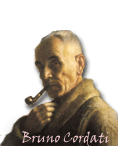
The museum-home Casa Cordati is currently in its
tenth year of activity. Its permanent show is organised chronologically
and by theme.
In the Studio Room (sala dello studio), where artist Bruno Cordati
worked during his last years, are his classic works dating back
to the '20s and '30s, described by Emilio Pasquini as «highly
human in content». These paintings were exhibited in various
shows of the period, leading the way to Cordati's participation
at the Venice Biennale in 1928.
In an article from that time (1930), L. G. Paolini praised Cordati's «precise
drawing technique, rigorous perspective planes and highly effective
contrasts of light». Two years later, in L'Eroica, Cozzani
wrote about his use of colour «...which is never muddy and
nebulous, but rises from the darkest greys and browns to the boldest
shades of white, green, red and yellow, through free associations
of tones which blend and confer a sense of daring yet harmonious
modern music".
On display in the Studio Room and shown for the first time to the
public is «Donna alla finestra», a painting dating
back to the ‘30s and echoing in its style, colours and atmosphere
the more celebrated «Giovinetta seduta».
Also exhibited for the first time in the show are two studies for
the painting «In soggettiva». These drawings were found
last winter inside a small notebook along with other sketches (of
landscapes, animals and figures). «In soggettiva» is
one of Cordati’s most important works, «having received
a highly authoritative praise, that of Marinetti» (Paccagnini).

The Middle Room (sala di mezzo) has been called
this way since 1985, when the first posthumous show of Bruno Cordati
was organised. At that time the exposition space only comprised
the three rooms facing the garden, and this was the room in the
middle. The last room, called Long Room (sala lunga), was modified
in 1997 by artist Alberto Garutti, who subdivided it and enlarged
the exhibition area that had characterised Casa Cordati in its
first three years as museum-home. Since Garutti's intervention,
there have been Long Room A (sala lunga A) and Long Room B (sala
lunga B).
In the Middle Room and the Long Room A, visitors
can view works from the '60s and '70s. As in last year's selection, they follow
a theme, a common thread. In many works of the late Cordati the
human figure is still present but it undergoes a metamorphosis.
The faces lose their features, the bodies become stocky, almost
limb-less, they resemble manikins, cocoons. These shapes seem like
the beginning of something; or its end. Humanity seems to fade
into the paintings’ increasingly magmatic background. The
contrast with the luminosity and bright colours of the works in
the preceding room is extreme but intentional. One can interpret
these three rooms according to a cycle: life ending and beginning
once again.
Retracing one's steps, one enters the Kitchen Room (sala della
cucina) and the New Room (sala nuova), the latter owing its name
to the fact that it was the last room added to Casa Cordati's museum
space.
In these rooms we chose to address the theme of the child in Bruno
Cordati’s oeuvre. This theme was much visited by the artist
from the very beginning. «A great flowering of children…»,
says Emilio Pasquini about the artist’s show in Lucca in
1923; and Cordati’s only painting at the Galleria d’Arte
Moderna in Rome is «Testa di bimbo» («Child’s
head»), bought in 1921 by the undersecretary of the Belle
Arti (ministry of culture). Yet the children painted by Cordati
in the late period are very different from those of the previous
years. One can scarcely talk of «flowering», and they
are rarely represented in child-like attitudes; most often they
have adult expressions, or they communicate feelings of infinite
sadness, sometimes of desperation.
The Room of Drawings (sala dei disegni) provides a curious window
on Cordati's work which we wished to maintain, and includes mostly
studies and sketches. The Bulgarian Room (sala bulgara), instead,
is a new addition, containing works dated from 1939 to 1943, when
Cordati taught in Bulgaria. Here it might seem as if we are discovering
a different artist; during one of the happiest periods of his life,
in fact, Cordati painted in «exceptionally rich and luminous» tones
(Paccagnini).
Personal
and collective exhibition
- 1921
Pacini Institute, Lucca
- 1922
Permanent Exhibition, Bagni di Lucca
- 1923
First Regional artistic exhibition, Casino dei Nobili, Lucca
- 1925
First artistic exhibition, Barga
- 1926
IV Spring Exhibition, Livorno
- 1927
XCIII Esposizione Amatori e Cultori delle Belle Arti
- 1928
II Art Exhibition, Fiume
- 1928
XVI International Art Exhibition, Venice
- 1929
Palazzo Ducale, Lucca
- 1930
IV Regional Tuscan Art Exhibition, Florence
- 1930
Personal Exhibition, Circolo Lucchese, Lucca
- 1931
II Provincial Exhibition of Art, Lucca
- 1931
Personal Exhibition, Bottega d'Arte, Livorno
- 1931
Personal Exhibition, Barga
- 1931
Personal Exhibition, Casa d'Arte, La Spezia
- 1932
Personal Exhibition, Circolo Lucchese, Lucca
- 1932
Personal Exhibition, Kursaal, Viareggio
- 1934
Personal Exhibition, Circolo Centro, Viareggio
- 1934
I Summer Exhibition, Kursaal, Viareggio
- 1935
Art exhibition, Barga
- 1937
IV Art Exhibition, Lucca
- 1945
Provincial Art Exhibition, Lucca
- 1946
II Provincial Art Exhibition, Lucca
- 1947
Art Exhibition, Barga
- 1978
Art in Lucca 1900-1945, Palazzo Mansi, Lucca
- 1980
Retrospective Exhibition, Barga
- 1985
Anthological Exhibition, Barga
- 1986
Anthological Exhibition, La Nuova Strozzina (Palazzo Strozzi),
Florence
- 1988
Anthological Exhibition, Palazzo Lanfranchi, Pisa
- 1990
Anthological Exhibition, Sophia and Plovdiv, Bulgaria
- 1993
Anthological Exhibition, Fontana del Delfino Gallery, Bergamo
- Since
1994 Permanent Exhibition, Palazzo Cordati, Barga.
|